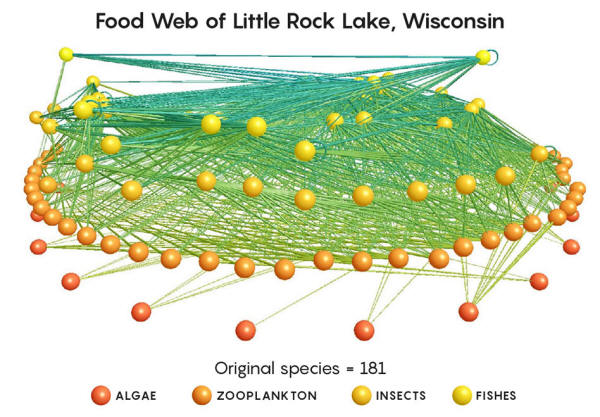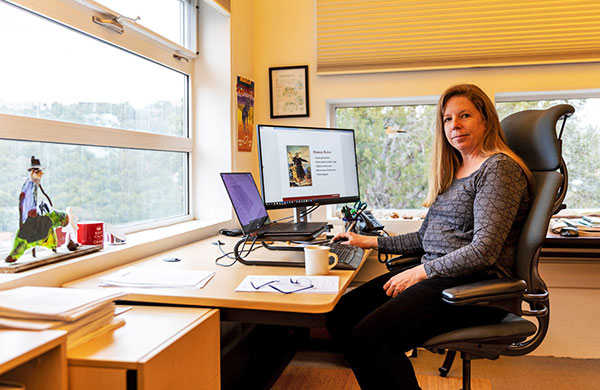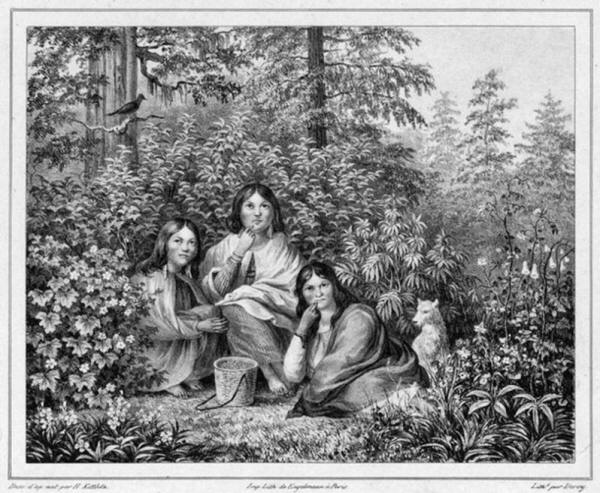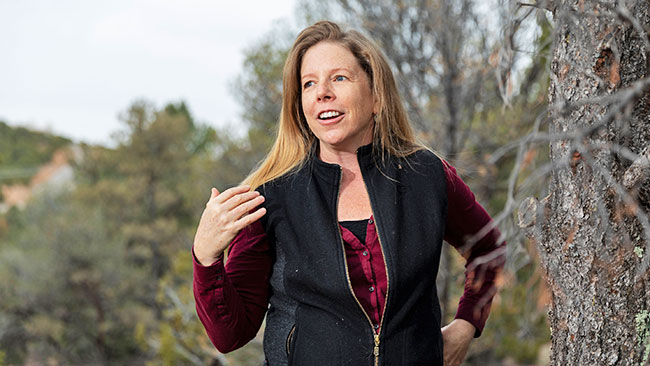When you build a food web, does it only entail figuring out
every single species that's in a place and then connecting the
dots between them?
At its simplest, that is exactly what a food web is.
Get as detailed a
species list as you can, and then figure out what each species
eats out of that list. That sounds simple in principle. In
practice it's very hard!
In terrestrial systems, for example, we often don't know much
about the insects.
Or you can have more
detailed information about what species are there, but you may
know nothing about what they eat, apart from "this insect eats
plants."
When you constructed the Burgess Shale food web, it seemed to
come down to what can fit its mouth around what.
Right, exactly.
In every paleo-food
web that I've been involved with, basically every link is a
hypothesis of a feeding interaction. Then it's annotated with
one or more lines of evidence.
Based on the
evidence, we assign it a certainty level. That makes it easier
for people down the line to reevaluate and tweak it. They're
living, breathing data sets.
It's not like we ever
have a perfect understanding. It's just a representation.
So tell me about these food web visualizations.
They all kind of look
like layer cakes.
In those food webs, the vertical axis has ecological meaning.
That's trophic level. At the bottom you have primary producers,
like plants or algae, which make their food through
photosynthesis.
That's trophic
level 1.
The next layer is
herbivores, things that eat only primary producers.
That's trophic
level 2...

This "layer cake" diagram
represents the food web documented in one Wisconsin lake.
At
the bottom are the primary producers,
such as photosynthetic algae, that make up trophic level 1.
Other organisms occupy higher tiers,
depending on the average length of the
individual food chains that connect them
to
primary producers.
Courtesy of Jennifer Dunne
For something above an herbivore, you follow all the different
food chains that connect it to a primary producer, and then you
do an average over those.
If, say, something
only eats herbivores and doesn't eat plants, then it would be at
trophic level 3, because it's two steps away from the primary
producers. But many things that eat herbivores also occasionally
eat a plant or an alga.
They're omnivorous,
which means they're eating at different trophic levels.
So almost everything
above herbivores has a fractional trophic level, for example,
2.5.
Once you have the layer cake, what can you do with it? What does
that shape tell you?
Basically, that shape gives you one way of characterizing the
architecture of ecosystems.
When you have that
data, you can visualize it in compelling ways and evaluate it
for different properties. Like, what fraction of things in the
system are humans feeding on, and how does that compare to other
consumers in the system?

Jennifer Dunne in her office (left) at the Santa Fe Institute,
where she is vice president for science.
Her work on using the networked structures of food webs
to gain insights into the dynamics of species interactions
within ecosystems has been immensely influential.
Gabriella Marks for Quanta Magazine
So what
have you learned about humans' place in food webs?
Humans are very omnivorous - and because of that, they are not
at the top of the food web.
Humans are usually
kind of in the middle to upper third of the food web for the few
systems that I've studied. People tend to think humans are at
the top.
Well, humans are
often at the tops of their individual food chains, but because
they're eating everything from plants all the way up to top
carnivores, they end up being in the middle of the whole food
web.
Of course, all that's ignoring parasites and viruses.
I have
separate work on including
parasites in food webs, but that's a whole different story. But
if you ignore parasites and viruses and
our microbiome, humans are
generally at the top of food chains now.
In pre-modern times,
other things would eat us. That's not so much the case anymore.
Humans also have short path lines to other species.
They have basically
two degrees of separation from over 90 percent of the species in
the food web, to put it in "Kevin Bacon" terms:
Often they're
directly feeding on a quarter to 50 percent of the species,
and then almost everything else is connected to those
species.
So within two links
you can get anywhere.
Does that
make us special as a species?
In the systems I'm looking at right now, humans are super
generalists.
They feed on many
more things than almost all other species.
In any food web, most animals are fairly specialized in what
they eat. Most eat 10 or fewer things. You have a few things
that eat more and more.
And then out at the
very end of the long tail of the distribution is where humans
tend to be. In a sense, that is special.
However, there are always some kinds of generalists in a system.
I mean, in the case of the Sanak Aleut near-shore marine food
web, there are two super generalists:
us and cod.
Pretty much anything
cod can stuff into their mouth and take a bite of, they do.
Video: Jennifer Dunne of the Santa Fe Institute
explains how reconstructions of food webs in
past ecosystems help ecologists understand both
the unusual niche of humans and new clues to a
more sustainable civilization.
Gabriella Marks for Quanta Magazine
That makes me feel less special.
Right! I expect that's not always going to be the case.
One of the open
questions is, how general is that pattern? Each of the systems
I'm looking at is quite different, and the humans have access to
different kinds of species. But they're still ending up as super
generalists.
Humans are very flexible. That's one of our characteristics.
We've spread all over the world, and we've been successful at
invading and becoming a part of many different kinds of
ecosystems.
That's really what we
want to get at with this new project - thinking about all the
ways humans interact with species.
How is the
new project different from the food webs you've made before?
The food webs show all the species in a system and one kind of
interaction between them, which is feeding.
With these human-use
webs, we've reduced it to focus only on all the links to and
from humans. But instead of just doing feeding, we're expanding
out to many categories of interaction.

This painting shows First Nations women
of the Pacific Northwest Coast gathering berries
-
one of humans' oldest and simplest interactions with another
species.
The pictured women are Tlingit; Dunne has studied this
interaction
among the Nuu-chah-nulth people.
F.H. Kittlitz from Voyage autour du monde, 1826-1829
by Fedor P. Litke, 1835, pl. 5b.
These interactions can be simple or complex.
One example is from
the
Nuu-chah-nulth people of the Pacific Northwest Coast in
Canada. (In talks, I use a painting of Tlingit women eating
berries to illustrate this point, but our data are from the Nuu-chah-nulth.)
You've got the
humans, and whatever the species of berry is and the link
between them. It's very simple - two nodes, one link: They
wander out into the woods and gather berries.
In the same system, humans eat whales. Two nodes, one link,
totally different story!
This huge complex of
many species and many types of interactions is required for
humans to successfully hunt, kill and eat the whale.
You have to
make a canoe, which is a complex technology in and of itself.
You have to use a
dozen different plant species and 10 different animal species.
You have to make all
the things that go along with canoeing, like air bladders.
You
have to make spears and protective clothing for yourself.
The Nuu-chah-nulth
people go through rituals to make sure the hunt is likely to be
successful.
And then they have to
haul the whale back to the beach and cut it up and do more
rituals, and they may or may not prepare the meat or blubber in
different ways.
That's probably the most complex of the complex interactions.
But many things are like that.
What new insights can you gain from this analysis?
It's providing new kinds of species-interaction data centered
around humans, which give us access to this slew of interesting
ecological, cultural and socio-ecological questions.
And it gives us a new
way, I hope, to think about sustainability. We're studying some
systems that had bad environmental outcomes, like species loss
and environmental degradation, and also human cultural chaos or
breakdown.
Are there lessons for
thinking about sustainability, now and into the future?

This kinetic sculpture by the local artist
Michael Schippling hangs on Dunne's office wall.
Dunne sees such works as creative examples
of complex systems
-
the special focus of the Santa Fe Institute -
and
a reminder of the intricate networks
of
connections linking humans to the rest
Photo: Gabriella Marks for Quanta Magazine;
art: Michael Schippling
There's an example that was
recently written up by a member
of our working group,
Stefani Crabtree of the
Santa Fe Institute and Utah State University, and her
colleagues.
In the Western Desert
of Australia, the
Martu Aboriginal people have been a part of
that ecosystem for many tens of thousands of years.
There is no system
without the Martu. But the modern Australian government decided
to pull them off that land.
The Martu were
setting small-scale fires to enhance their ability to hunt
large-bodied lizards, and once they were pulled off the land,
very quickly it messed up the ecosystem.
You have extinctions
of small mammals; you have massive wildfires that start because
no one is doing this patchwork mosaic burning.
So now the Martu
are going back onto the land and starting to do their
traditional burning practices, and that's helping to restabilize
the system.
But then in the case of the
Sanak Aleut, who came into the
Aleutian Island system 7,000 years ago, there's no apparent
disruption. There's no known short- or long-term local species
extinction.
They were able to fit
in and become a part of the ecosystem.
So what makes an ecosystem fall apart versus keep going for
7,000 years?
The Sanak
Aleut were poised to play potentially destructive
roles as highly omnivorous super
generalists.
They brought hunting
technology, which lets humans feed at a greater rate than you
would expect from animals of their body size. But humans also
have characteristics that allowed these super-generalist
omnivores with hunting technology to come into the system and
not wreck it.
One was that, like other generalist feeders, the humans could
and did prey switch.
Generalists may feed
on a lot of different things in a system, but they tend to focus
on a very few things at any given time. The Sanak Aleut's
preference was to hunt sea lions, but most of the time they
couldn't do that.
The weather was
terrible. They couldn't launch their kayaks. And so they would
go gather stuff in the intertidal, focusing on big, juicy things
first. Then when the salmon came in, they would drop everything
else and go harvest salmon.
So they were
constantly switching.
One of the effects of prey switching is that it allows the
previous prey species to recover. We know from dynamical
modeling that that's very stabilizing in terms of coexistence
and persistence of species.
The Sanak Aleut also weren't using all their hunting technology
all the time. They had fancy tech for getting in kayaks and
hunting sea lions, but most of the time they weren't doing that.
They were just going
out and gathering stuff.
Is there a
prey-switching analogy for the present day?
There's an anti-prey-switching analogy!
Bluefin tuna is an
example I use a lot.
Bluefin tuna are in very high demand in the
international sushi market, so they get hunted commercially. As
they've become more rare, they've become more valuable.
You get this perverse anti-ecological dynamic. In an ecological
system, as something becomes rarer and harder to find, its
ecological value goes down.
That's why predators
prey switch:
They have to
expend too many calories to try to get that prey, or it's
too dangerous.
But in a luxury
market, all of a sudden you get the perverse incentive to hunt
more because it's worth more and more money...
A bluefin tuna was
just sold recently for more than 3 million dollars, a new
record.
It's bad for the bluefin tuna, right? But that also introduces a
bad dynamic into the whole system. It's destabilizing - not just
for bluefin tuna but potentially for the whole food web.
The tuna are embedded
within a whole network of interactions.
And that's part of the point of doing food web research, or
interaction research. You pull out one node, you pull out one
interaction, and it's not just about those species.
It's about impacts
that can potentially ripple throughout the whole system, and
often in unexpected ways.






